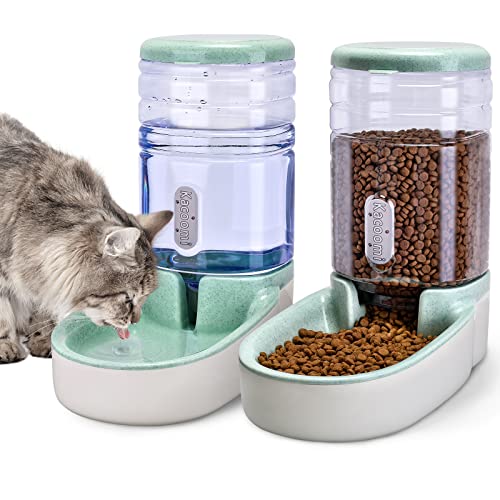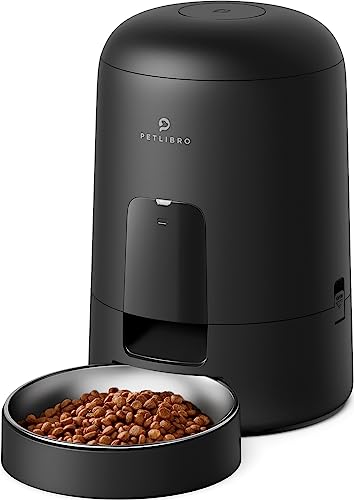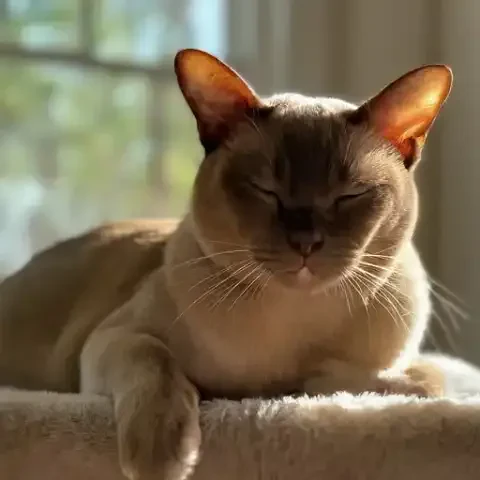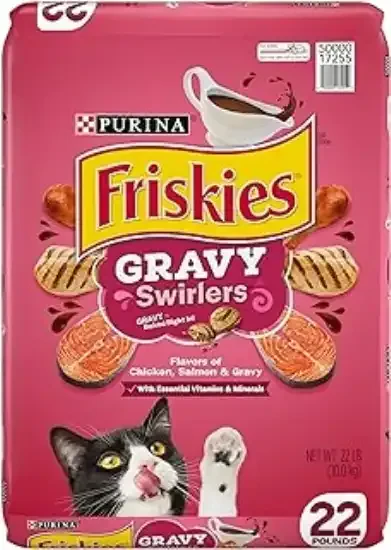Imagine a feline companion who embodies the plush beauty of a Persian but welcomes you with the playful spirit of a kitten, a creature who exudes gentle charm and cuddly appeal. This is the Exotic Shorthair, often lovingly called the "teddy bear" of the cat world, a breed that melts hearts with its sweet disposition and undeniably huggable presence. They are more than just shorthaired versions of Persians; they are a breed in their own right, possessing a unique blend of Persian grace and an easygoing nature that makes them truly enchanting companions. This article invites you to discover the delightful world of the Exotic Shorthair, to explore their captivating history, admire their plush and rounded physique, understand their charmingly gentle personality, delve into the simple joys of their care, and ultimately, understand why these cuddly felines have become such beloved members of countless homes around the globe. Prepare to be utterly charmed by the peaceful presence and endearing nature of the Exotic Shorthair cat.
To truly appreciate the Exotic Shorthair, it's essential to understand their fascinating origin story, a tale that begins with Persian cat breeders and an unexpected twist of fate. The Exotic Shorthair wasn't initially conceived as a breed in itself; rather, they emerged from Persian breeding programs in the 1960s. Persian breeders, seeking to introduce the striking silver color into their Persian lines, began to outcross Persians with American Shorthairs, hoping to broaden the gene pool and achieve this desired hue. While the silver color was indeed sometimes achieved, an unforeseen and delightful surprise emerged alongside it: shorthaired kittens that, while lacking the signature long flowing coat of Persians, remarkably retained the coveted Persian body type, facial features, and, crucially, the gentle and sweet Persian temperament. These shorthaired kittens, initially considered a bit of an anomaly in Persian breeding programs, possessed a unique charm all their own. They were, in essence, "Persians in pajamas," capturing the essence of the beloved Persian breed in a more manageable, short-coated package. It was in this serendipitous twist of genetics that the Exotic Shorthair was born, an accidental beauty that would soon capture the hearts of cat lovers seeking the Persian charm without the high-maintenance grooming demands.
Breeders quickly recognized the inherent appeal of these "shorthaired Persians." The idea of a cat that possessed the gentle, loving nature and undeniably plush, rounded appearance of a Persian, but with a shorter, easier-to-care-for coat, held immense appeal. This realization sparked intentional breed development, as breeders began to selectively breed these shorthaired Persian-type cats, focusing on refining their unique characteristics and establishing them as a distinct breed, rather than simply a shorthaired Persian variant. The desire to create a "low-maintenance Persian" became a driving force, catering to cat enthusiasts who adored the Persian aesthetic and temperament but sought a feline companion that fit more seamlessly into busy modern lifestyles without the extensive daily grooming required by their longhaired counterparts. The Exotic Shorthair offered the perfect solution: the beloved Persian qualities, beautifully packaged in a user-friendly, short-coated format.
The Exotic Shorthair's journey to official breed recognition was a relatively swift and successful one, mirroring their rapid rise in popularity amongst cat enthusiasts. Major cat registries, such as the Cat Fanciers' Association (CFA) and The International Cat Association (TICA), quickly recognized the unique appeal and distinct characteristics of the Exotic Shorthair, granting them breed status in the late 1960s and early 1970s. This official recognition solidified their place in the cat fancy world and paved the way for wider acceptance and appreciation. Their popularity continued to soar, often rivaling or even surpassing Persians in popularity within some cat registries. This surge in popularity was largely attributed to their easier grooming requirements compared to Persians, making them an accessible option for a broader range of cat lovers seeking a gentle, loving, and beautiful companion. Today, the Exotic Shorthair stands firmly established as a beloved and popular breed worldwide, a testament to their enduring charm and the enduring appeal of their "teddy bear" qualities.
The Exotic Shorthair’s physical appearance is a delightful study in rounded contours and plush textures, a visual embodiment of their "teddy bear" nickname. Their body type is decidedly cobby and rounded, a direct inheritance from their Persian ancestors, giving them a sturdy and substantial feel. They are classified as medium to large in size, possessing a solid, well-muscled physique that is both strong and huggable. Despite their substantial build, they are not bulky or overly heavy-set; rather, they possess a pleasingly rounded and balanced form, with soft curves and a general impression of plushness from head to toe. Their rounded contours and sturdy build contribute to their overall cuddly appearance, making them irresistibly huggable and reinforcing their reputation as the "teddy bear" of the cat world.
The defining physical feature of the Exotic Shorthair, the characteristic that truly sets them apart, is their short, dense, plush coat. This coat is often described as "teddy bear fur" for good reason; its texture is incredibly soft, dense, and luxurious, inviting touch and cuddles. Unlike the long, flowing coat of the Persian, the Exotic Shorthair boasts a short, dense coat that stands slightly away from the body due to its inherent thickness, creating a wonderfully rounded and plush appearance. This dense, plush coat is not only visually appealing and wonderfully soft to the touch, but it is also significantly easier to care for than the long, flowing coat of their Persian relatives, representing the breed's key appeal for those seeking Persian beauty with reduced grooming demands. It is this "teddy bear fur" that truly defines their cuddly aesthetic, making them an irresistible source of soft, plush comfort and affection.
Their head and face further contribute to their sweet and gentle expression, echoing the rounded theme found throughout their body. The Exotic Shorthair boasts a round, broad head, characterized by soft, rounded contours and a general lack of harsh angles. Their cheeks are full and rounded, contributing to their cherubic facial appearance and enhancing their overall impression of sweetness and gentleness. Their facial features are open and expressive, conveying a sense of calm and amiable disposition that is instantly endearing. This rounded head and sweet facial expression further solidify their "teddy bear" image, creating a face that is both charming and utterly approachable.
Inherited from their Persian lineage, the Exotic Shorthair possesses a flat face and a short, snub nose, contributing to their distinctive brachycephalic (short-headed) facial structure. While they share this flat-faced trait with Persians, it is important to note that the degree of flatness can vary, and responsible Exotic Shorthair breeders prioritize moderate facial structure to minimize potential breathing issues associated with extreme brachycephaly. While their noses are undeniably short and snub, contributing to their characteristic "pansy face," it is crucial that breeders focus on maintaining a balance, avoiding overly flattened faces that can lead to health problems. Compared to some extreme show-style Persians, many Exotic Shorthairs exhibit a somewhat less extreme facial flatness, potentially resulting in fewer breathing difficulties in some lines, though they are still considered a brachycephalic breed and require responsible breeding practices to prioritize health.
Completing their cherubic facial features are their large, round, and remarkably expressive eyes, radiating sweetness and often conveying an almost innocent gaze. The Exotic Shorthair possesses large, round eyes, set wide apart on their broad face, enhancing their open and gentle expression. Eye color is typically vivid and striking, with copper or brilliant orange being the most common and highly desired hues, particularly in traditional coat colors. However, eye color can vary depending on coat color, with silver and golden Exotic Shorthairs often exhibiting striking green eyes, and pointed Exotic Shorthairs showcasing captivating blue eyes. These large, round, and expressive eyes are crucial to their overall sweet and gentle appearance, lending them an endearing and often irresistibly innocent gaze that melts hearts.
Their ears, small and rounded, perfectly complement their round head and contribute to their overall soft and cuddly aesthetic. The Exotic Shorthair boasts small, rounded ears, set wide apart on their broad head and tilted slightly forward, enhancing their attentive and sweet expression. Their small size and rounded shape harmonize seamlessly with their rounded head and facial features, contributing to their overall impression of soft, cuddly plushness. These small, rounded ears are yet another detail that adds to their "teddy bear" charm, completing their gentle and approachable appearance.
Their legs and tail further contribute to their stocky and grounded "teddy bear-like" build. The Exotic Shorthair possesses short, thick, and sturdy legs, proportionate to their cobby body and contributing to their solid and grounded stance. Their tail is also short, thick, and rounded at the tip, held at a lower angle and completing their balanced and stocky silhouette. These shorter, thicker limbs and tail enhance their overall impression of being a cuddly, grounded, and undeniably "teddy bear-like" feline companion.
Mirroring their Persian ancestry, Exotic Shorthairs boast an incredible variety of coat colors and patterns. In fact, they come in virtually every color and pattern found in Persians, showcasing the same breathtaking diversity in a short-coated format. From solid, self-colored Exotic Shorthairs in hues of white, black, cream, red, and blue, to captivating bi-color and parti-color variations, the possibilities are seemingly endless. Tabby patterns, tortoiseshell patterns, pointed patterns (inherited through Himalayan lineage in Persian breeding), shaded and smoke patterns – all the visual richness and diversity found in Persians is beautifully replicated in the short, plush coat of the Exotic Shorthair. This vast array of colors and patterns ensures that there is an Exotic Shorthair to capture every heart and aesthetic preference, all presented in a package of irresistible cuddly charm and low-maintenance grooming ease.
Beneath their plush and rounded exterior lies a temperament that is as charming and gentle as their appearance suggests. Exotic Shorthairs are renowned for their exceptionally sweet, gentle, and docile nature, often cited as one of the breed's defining characteristics. They are calm, quiet, and easygoing cats, perfectly embodying the ideal of a relaxed and undemanding feline companion. Their gentle disposition extends to all aspects of their personality, making them wonderful additions to a variety of households seeking a peaceful and loving cat. Their reputation for being affectionate and undemanding companions is well-deserved, as they readily offer love and companionship without being overly clingy or high-maintenance.
Affection and love are at the heart of the Exotic Shorthair personality. They are undeniably affectionate and loving cats, thriving on human interaction and actively seeking out cuddles, pets, and simply being near their beloved owners. They are lap cats through and through, happily settling onto laps for extended cuddle sessions, purring contentedly and reveling in close physical contact. Their desire for affection is genuine and heartwarming, making them wonderfully rewarding companions for those seeking a feline friend who is truly devoted and demonstrably loving. Their quiet presence and gentle affection make them ideal companions for those seeking a peaceful and calming feline presence in their home.
While known for their calm and gentle nature, Exotic Shorthairs also possess a moderately playful and curious spirit. They are not hyperactive dynamos, but they do enjoy gentle play and exploring their environment with a quiet curiosity. Their playfulness is generally less intense than some of the more energetic breeds; they are more inclined to engage in gentle swatting at toys, batting at dangling objects, and exploring their surroundings at a relaxed pace. They enjoy toys and appreciate interactive playtime with their owners, but they are not necessarily demanding of constant high-energy antics. Their playfulness is charmingly understated, adding a touch of gentle amusement to their overall calm and peaceful demeanor.
Their vocal nature mirrors their overall gentle personality – quiet and soft-voiced. Exotic Shorthairs are typically not very talkative cats, preferring to communicate through soft purrs, gentle chirps, and subtle body language rather than loud or demanding meows. Their meows, when they do vocalize, are often described as soft and melodic, perfectly reflecting their gentle and non-intrusive presence. They are communicative in their own quiet way, letting you know their needs and affections with subtle and endearing vocalizations, making them wonderfully peaceful companions for those who appreciate a quieter feline friend.
Loyalty and devotion are deeply ingrained in the Exotic Shorthair temperament. They are known for forming strong bonds with their families, displaying unwavering loyalty and a deep desire to be an integral part of the household. They are not aloof or independent cats; they thrive on being included in family life and actively seek to be near their loved ones, offering quiet companionship and a comforting presence. Their reputation as excellent family pets is well-deserved; their gentle nature, patience, and devotion make them wonderful additions to households of all types, bringing a sense of calm and loving stability to the family dynamic.
Their gentle and tolerant demeanor extends to their interactions with children and other pets, making them well-suited for multi-species households. Exotic Shorthairs are generally known to be good with children, displaying patience and tolerance, especially when children are taught to interact with them gently and respectfully. They also tend to be accepting of other pets, including cats and even cat-friendly dogs, often coexisting peacefully and even forming amicable relationships with their housemates. Their adaptable and gentle nature makes them wonderful additions to homes with existing pets and families with children, bringing a sense of harmony and gentle companionship to the multi-pet household.
Adaptability and an easygoing nature are further hallmarks of the Exotic Shorthair temperament. They are remarkably adaptable cats, readily adjusting to different home environments and routines, making them suitable for a variety of lifestyles. They are relatively easygoing and unfazed by changes, generally handling transitions and new situations with calm and composure. Their adaptable nature and gentle disposition make them well-suited for a wide range of living situations, from quiet apartments to bustling family homes, bringing a sense of peaceful stability wherever they reside. Whether you live a quiet, relaxed lifestyle or a more active family life, the adaptable and easygoing Exotic Shorthair can seamlessly integrate into your world and offer their gentle companionship.
Caring for an Exotic Shorthair, while significantly easier than caring for a Persian, still requires a dedicated owner willing to meet their specific needs. Grooming, while undeniably easier than with a Persian, is still a necessary part of Exotic Shorthair care. While their short coat eliminates the daily hours of brushing required for Persians, regular brushing, about two to three times a week, is still recommended to remove loose hair and prevent potential matting, particularly given the density of their plush coat. Regular brushing also helps to distribute skin oils, keeping their coat healthy and lustrous. While less prone to matting than Persians, their dense coat can still benefit from regular attention to maintain its plush texture and overall cleanliness. In addition to brushing, regular bathing, every few months or as needed, is beneficial for Exotic Shorthairs, helping to remove oil buildup and keep their plush coat clean and fresh.
Facial care is a specific need for Exotic Shorthairs, stemming from their flat faces and the anatomy of their tear ducts. Their brachycephalic facial structure can sometimes lead to increased tear production and reduced tear drainage, resulting in tear staining around the eyes. Daily gentle cleaning of the eye area with a soft, damp cloth is recommended to prevent tear staining and keep their faces clean and comfortable. For more persistent tear staining, feline tear stain remover products, available at pet supply stores, can be used, but always with caution and following product instructions carefully. Consistent daily facial cleaning is a simple but important routine for maintaining the cleanliness and comfort of your Exotic Shorthair's face.
Diet and nutrition are crucial for maintaining a healthy weight in Exotic Shorthairs. They can be predisposed to weight gain, particularly as they mature and become less active, especially given their love of food and often less energetic nature compared to some breeds. Feeding them a high-quality, balanced cat food in measured portions is essential to prevent obesity. Monitoring their weight regularly and adjusting food portions as needed is important to maintain a healthy body condition throughout their lives. Obesity can exacerbate potential brachycephalic airway issues and other health problems, so weight management is a key aspect of responsible Exotic Shorthair care.
While not hyperactive, Exotic Shorthairs still benefit from moderate daily exercise and playtime to maintain their physical and mental well-being. Gentle play sessions with toys, puzzle feeders, and interactive games are all excellent ways to provide them with appropriate levels of activity. They enjoy less strenuous activities, such as exploring their surroundings, birdwatching from windows, and engaging in short bursts of playful interaction with their owners. Overexertion is not necessary or desirable; gentle activity that stimulates their minds and bodies is perfectly sufficient to keep them happy and healthy.
Like Persians, Exotic Shorthairs can be predisposed to certain health conditions due to their lineage and shared physical conformation. It is important to be aware of these potential health concerns, while also emphasizing that not all Exotic Shorthairs will develop these conditions, and responsible breeding practices can significantly minimize risks. Some potential breed-specific health concerns that have been associated with Exotic Shorthairs, inherited from their Persian lineage, include Polycystic Kidney Disease (PKD), a hereditary kidney disease; Brachycephalic Airway Syndrome, related to their flat faces and potentially causing breathing difficulties; Progressive Retinal Atrophy (PRA), a degenerative eye condition; and Hypertrophic Cardiomyopathy (HCM), a heart condition. Choosing a reputable breeder who screens their breeding cats for these conditions is crucial when considering acquiring an Exotic Shorthair kitten. Regular veterinary checkups and preventative care throughout their lives are also essential for early detection and management of any potential health issues, particularly regarding breathing and eye concerns related to their brachycephalic facial structure.
Living with an Exotic Shorthair is to welcome a peaceful and loving presence into your home. The ideal home environment for an Exotic Shorthair is one that is calm, loving, safe, and predictable, reflecting their gentle and easygoing nature. They thrive in homes where they receive plenty of affection, attention, and quiet companionship, and where their gentle personalities are appreciated and cherished. Owners who appreciate a quieter, more relaxed feline companion will find the Exotic Shorthair to be an ideal match. They are wonderful companions for apartment living, perfectly content to reside indoors as long as they are provided with sufficient love, attention, and indoor enrichment. They do not require large, sprawling spaces to thrive; their calmer nature and moderate activity levels make them well-suited for smaller living environments. Their gentle and undemanding nature makes them an excellent choice for seniors and less active individuals who seek a loving and peaceful feline companion. Their lap cat tendencies and love of quiet companionship make them particularly well-suited for providing comfort and gentle affection to those seeking a calmer and less demanding pet.
The joys of owning an Exotic Shorthair are abundant and deeply rewarding. They bring an unparalleled level of peaceful companionship and unconditional love into a home. Their sweet nature, affectionate devotion, gentle purrs, and cuddly "teddy bear" qualities create a truly calming and heartwarming feline presence. The bond formed with an Exotic Shorthair is a deeply fulfilling one, built on quiet companionship, gentle affection, and the comforting presence of a truly charming and cuddly feline friend. While incredibly rewarding, it's important to acknowledge the potential considerations, primarily the need for daily facial cleaning to prevent tear staining and the importance of weight management to prevent obesity. However, these are manageable aspects of their care, easily incorporated into a routine, and pale in comparison to the immense joy and gentle companionship they bring to their owners.
For those considering welcoming an Exotic Shorthair into their lives, common questions often arise. Are Exotic Shorthair cats hypoallergenic? Unfortunately, no cat breed is truly hypoallergenic, and Exotic Shorthairs are not considered to be hypoallergenic. They do shed, despite their short coat, and produce allergens just like any other cat. Allergic reactions are highly individual. Are Exotic Shorthair cats good for first-time cat owners? Yes, they are often considered a good choice for first-time cat owners due to their gentle and easygoing nature, relatively lower grooming needs compared to Persians, and adaptable personalities, making them quite forgiving for novice cat owners. Do Exotic Shorthair cats shed much? They are moderate shedders. While short-haired, their dense double coat does shed, and regular brushing helps manage this shedding. Are Exotic Shorthair cats expensive? The purchase price from reputable breeders can be moderate to high, similar to Persians. Ongoing costs are typical for cat ownership: food, litter, vet care. You may also factor in the cost of tear stain cleaning products if needed. How long do Exotic Shorthair cats live? Typically 12-15 years on average, and sometimes longer with good care, mirroring the lifespan of Persians. Are Exotic Shorthair cats prone to any specific health problems? They share some predispositions with Persians, including PKD, brachycephalic issues, PRA, and HCM, but not every cat will develop these, and responsible breeding minimizes risks. Regular vet checkups are important. Are Exotic Shorthair cats good indoor cats? Yes, they are ideally suited for indoor living due to their calmer nature and lower exercise needs, thriving in apartment settings and enjoying a safe, indoor environment. Can Exotic Shorthair cats be left alone? They can tolerate being alone for reasonable periods, but they thrive on companionship and attention and benefit from having owners home or another pet companion for company. What's the best way to play with an Exotic Shorthair cat? Gentle play is best – wand toys, soft toys, puzzle feeders, engaging in interactive games that are not overly strenuous, reflecting their calmer energy levels. Where can I get an Exotic Shorthair cat? Reputable breeders are recommended for kittens, ensuring health and temperament. Also consider breed-specific rescues or Persian rescues, and general cat rescues, as Exotic Shorthairs might sometimes be mislabeled as Persians in rescue settings.
In conclusion, the Exotic Shorthair is more than just a shorthaired Persian; they are a breed that embodies gentle charm, cuddly comfort, and a peaceful presence, bringing the plush beauty of a Persian into an easy-to-love and lower-maintenance package. Their defining traits – their sweet and gentle temperament, their plush and inviting "teddy bear" appearance, their rounded contours and soft features, and their adaptability and loving devotion – all combine to create a feline companion that is truly endearing and exceptionally rewarding. For those seeking a cat who is both beautiful and easy to love, a creature who will bring a sense of calm, cuddly comfort, and unwavering gentle companionship into their home, the Exotic Shorthair is a breed that truly captures the essence of feline charm and offers a lifetime of peaceful and loving feline friendship. To discover the Exotic Shorthair is to discover a world of gentle purrs, soft cuddles, and the enduring appeal of a truly charming and heartwarming companion.







